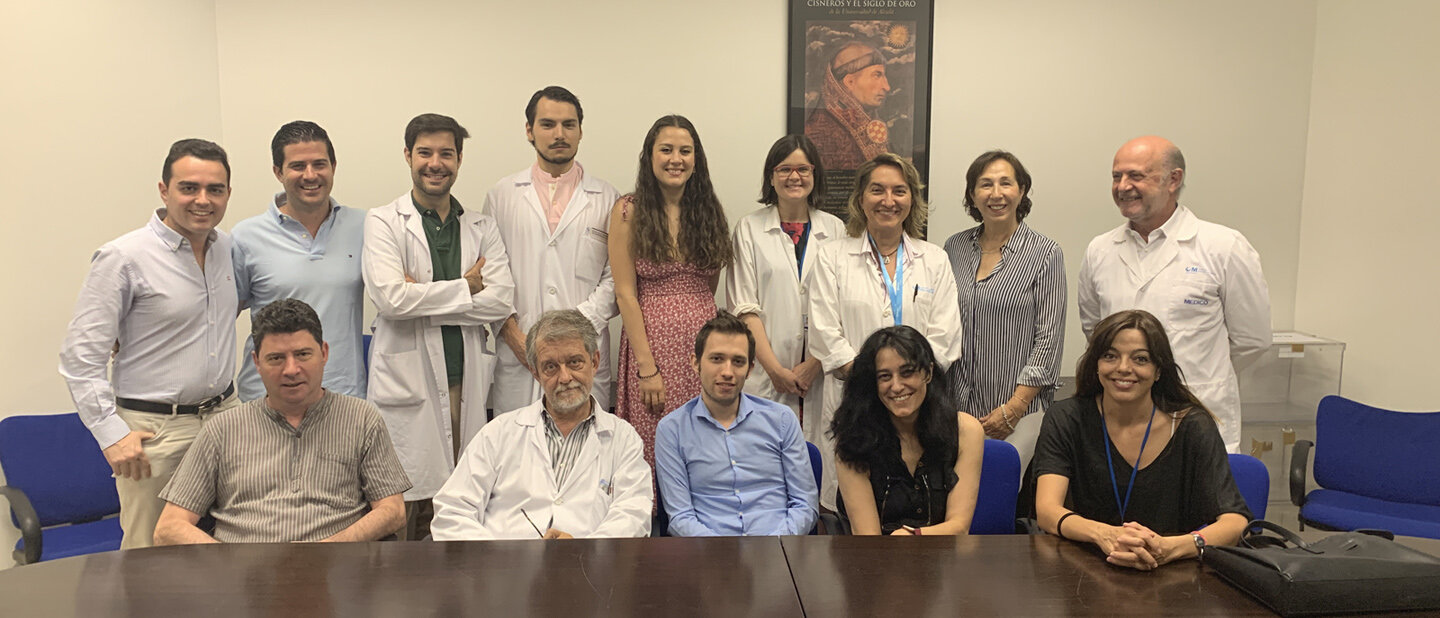Experimental Dermatology and Cutaneous Biology

Group leader
Álvaro González Cantero
alvarogc261893(ELIMINAR)@hotmail.com
Tlf.: +34 91 336 82 47
Principal Investigator
- Ángeles Juarranz de la Fuente
- Sergio Vañó Galván
- Pedro Jaén Olasolo
Collaborating Staff
- María Asunción Ballester Martínez
- Juan Pablo Boixeda de Miguel
- María Elena de Las Heras Alonso
- Natalia Jiménez Gómez
- María Bibiana Pérez García
- Luis Ríos Buceta
- Montserrat Fernández Guarino
- Marta Mascaraque Checa
- Gonzalo Segurado Miravalles
- David Saceda Corralo
- Laura Miguel Gómez
- Sonia Bea Ardebol
- Maria Gallego Rentero
- Jimena Nicolas Morala
- Elisa Carrasco Cerro
- Daniel Ortega Quijano
- Gerald Selda Enríquez
- Pablo Fernández González
- Ángela Hermosa Gelbard
- Belén de Nicolás Ruanes
- Azahara María Rodríguez Luna
- Ana Carlota Blanco Abbad-Jaime de Aragón
- Ana Laura Melian Olivera
- Patricia Burgos Blasco
- María Gonzalez Ramos
- Andrea Barahona López
- Cristina Vázquez Muñoz
- Paula Alcaraz Laso
- María Davó Mogica

Principal Investigator
- Ángeles Juarranz de la Fuente
- Sergio Vañó Galván
- Pedro Jaén Olasolo
Collaborating Staff
- María Asunción Ballester Martínez
- Juan Pablo Boixeda de Miguel
- María Elena de Las Heras Alonso
- Natalia Jiménez Gómez
- María Bibiana Pérez García
- Luis Ríos Buceta
- Montserrat Fernández Guarino
- Marta Mascaraque Checa
- Gonzalo Segurado Miravalles
- David Saceda Corralo
- Laura Miguel Gómez
- Sonia Bea Ardebol
- Maria Gallego Rentero
- Jimena Nicolas Morala
- Elisa Carrasco Cerro
- Daniel Ortega Quijano
- Gerald Selda Enríquez
- Pablo Fernández González
- Ángela Hermosa Gelbard
- Belén de Nicolás Ruanes
- Azahara María Rodríguez Luna
- Ana Carlota Blanco Abbad-Jaime de Aragón
- Ana Laura Melian Olivera
- Patricia Burgos Blasco
- María Gonzalez Ramos
- Andrea Barahona López
- Cristina Vázquez Muñoz
- Paula Alcaraz Laso
- María Davó Mogica
STRATEGIC OBJECTIVES
- Characterise growth factors and transcriptional regulators involved in the proliferation and differentiation of stem cells of the skin and in the regulation of the skin cycle, as well as pathologies related to the function/dysfunction of these cells.
- Implement new clinical therapies based on stem cells of the skin to encourage skin regeneration: burns and wounds, chronic ulcers and alopecia.
- Development of dermo-epidermal skin equivalents or new generation artificial skin prototypes. Assessment of the use of disease models at the clinical level or the assessment of the response to topical treatments.
- Implement diagnostic methods and therapeutic targets of non-melanoma skin cancer, especially premalignant lesions, such as actinic keratosis.
- Characterise the efficacy, safety and improvement of the morbimortality of new molecules or biological drugs for the treatment of psoriasis, atopic dermatitis and generalised vitiligo.
- Development of new technologies in the field of diagnostics in dermatology. Incorporation of cutaneous ultrasound, confocal microscopy and OCT in the diagnosis and monitoring of different cutaneous diseases and their comorbidities.
- Clinical trials with new therapeutic targets and the development of prevention strategies in patients at high risk of non-melanoma skin cancer and transplanted patients.
- Description of the genes and trichoscopy patterns associated with different types of alopecia.
- Characterise the clinical, histological and immune expression patterns of patients with severe drug reactions (NET, DRESS, Stevens-Johnson syndrome).
- Development and protocolisation of laser and non-coherent light sources (LLLT, LEDS) as treatment strategies, single light sources or for photodynamic therapy in different dermatologic pathologies (vascular malformations, ulcers, tissue regeneration, alopecia, acne).
- Creation of a gut microbiota biobank of patients with inflammatory and tumour dermatologic diseases.
- Unit for the treatment of vitiligo by melanocyte transplant in refractory cases of localised vitiligo.
- Operating in inter-service units in complex dermatologic pathologies: bullous disorders unit, lymphomas unit, apheresis unit, chemotherapy skin reactions unit and severe minority inflammatory diseases unit.
RESEARCH LINES
Regenerative dermatology and stem cells
- Characterisation of new mechanisms of stem cells regulation of the skin with potential applications in regenerative medicine and in the treatment of different cutaneous pathologies.
- Characterisation of molecular factors involved in pathologies associated with stem cells of the skin (alopecia and others).
Therapeutic targets in non-melanoma skin cancer
- Development of diagnostic methods and the identification of therapeutic targets of non-melanoma skin cancer.
Clinical dermatology
- Identification of new molecules, targets, biomarkers and factors associated with prognosis, comorbidity and treatment response in inflammatory dermatologic pathology.
- Implementation of non-invasive imaging diagnostic techniques in dermatologic pathology.
- Development of treatments for advanced non-melanoma skin cancer and strategies to prevent it, including high risk patients. Genetic and tricoscopic characterisation of alopecias.
- Characterisation and treatment of severe drug reactions and chemotherapy treatments.
- Research on the photochemical, photobiological, photomechanical and photobiomodulation effects when applying light sources in the treatment of skin diseases and malformations.
- Characterisation of the microbiota associated with dermatologic pathology.
- Development of melanocyte transplantation.
- Development of a multidisciplinary unit for the complex dermatological patient.
Trichology
- New therapies for androgenic alopecia (oral minoxidil).
- AntiJAK drugs for alopecia areata.
- Genetic characterization of patients with frontal fibrosing alopecia.
- Microbiota analysis in patients with alopecia areata and folliculitis decalvans.
Location
Ramón y Cajal University Hospital
Research Lanoratories. -3rd floor right
Dermatology Day Hospital. 8th floor centre
Outpatient appointments. 2nd floor Outpatient Appointments Building
+34 91 336 82 47
Keywords
regenerative medicine, stem cells, skin, hair, non-melanoma skin cancer, psoriasis, burns, wounds, chronic ulcers, alopecia, cutaneous microbiota, dermatology laser, imaging techniques in dermatology, photodynamic therapy, minority dermatological diseases, melanocytes transplantation, trichology, alopecia, androgenic alopecia, alopecia areata, frontal fibrosing alopecia, oral minoxidil
